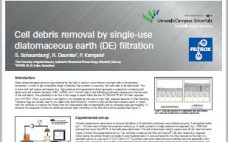Host cell protein (HCP) levels in drug products are critical to product quality since HCPs may pose a serious risk to patient safety. The challenge is to accurately quantify the complex mixture of HCP impurities, which vary in properties and abundance depending on the cell line, media, and process parameters. Generic immunoassays commonly used to measure HCP impurities are based on polyclonal antibodies raised against HCPs from non-transfected cell lines. How well a particular HCP assay recognizes all proteins depends…
2016 Collection
Enhanced Endotoxin Removal By Synergistic Effect of Positively Charged Depth Filtration and Polyethylene Glycol
Recombinant therapeutic proteins derived from E. coli require robust endotoxin removal, ideally performed using multiple process steps providing orthogonal and robust clearance. Typical recovery processes for E. coli expressed proteins consist of cell harvest by centrifugation, homogenization, collection of inclusion bodies by centrifugation, solubilization, refold, and clarification by depth filtration. Endotoxin clearance across the recovery operations is usually on the order of one log. Here, we demonstrate that endotoxin clearance can be enhanced to five logs by using 16% polyethylene…
Cell Debris Removal By Single-Use Diatomaceous Earth (DE) Filtration
Many biotechnological products are obtained by the help of native or recombinant microbial cells in fermentation processes. In order to get intracellular target molecules, like proteins or enzymes, the cells have to be destructed. This is done with cell rupture techniques (e.g. high-pressure homogenization) which generate a suspension containing cell debris and cell contents (proteins, DNA, mRNA, etc.). The first step in the following purification sequence is the removal of the cell debris. One possibility to do this is the…
Development and Optimization of CHOgro® Transient Expression Technologies for High Titer Antibody Production in Suspension CHO Cells
During early stage drug development, quickly obtaining relevant candidate proteins through transient transfection can accelerate drug dis-covery. High titers are often obtained from Human Embryonic Kidney (HEK) 293 derived cell types; however, the use of different host cells between early stage transient and later stable protein production is a concern and can lead to the advancement of false-positive candidates. Chinese hamster ovary (CHO) cells are a desirable target cell type due to growth characteristics and a history of regulatory approval;…
Development of a Novel Cold Chain Tubing, FP-FLEX™, and Single- Use Freezing Bag for Working Cell Banks Enabling Closed-System Processing to Temperatures as Low as -196°C
Working cell banks (WCB’s) are commonly applied to initiate cell culture manufacturing campaigns for production of therapeutic proteins. These campaigns typically begin with inoculation of cells previously cryopreserved in vials. While vials are typically used to establish WCB’s and initiate manufacturing campaigns, they are not optimal for the growing demands of commercial production. Vials are small and filling/removal is performed through an open cap. This process leads to numerous manual operations and culture vessels, resulting in contamination risks and potential…
Scaling Up Clinical T cell Expansion in a Xuri™ Cell Expansion System
Administration of antigen-specific T cells (ASTs), in particular for viral infections in transplantation, is one of the key focuses in immunotherapy. The Xuri™ Cell Expansion System can be used as an alternative to static cell culture methods for the stimulation and expansion of ASTs. The process described here demonstrates the use of the Xuri Cell Expansion System from the initiation of culture to the generation of virus-specific T cells. This includes a semi-static phase for antigen stimulation, a rocking phase…
Optimization of HEK 293 and CHO-S Cell Growth by Supplementation of Non-Animal Derived Components Using Design of Experiments (DoE)
Mammalian cells are a widely used expression platform for the production of recombinant therapeutic proteins or viral particle-based vaccines since they typically perform appropriate protein post-translational modifications and authentic viral particle assembly. Of the available mammalian cells, CHO and HEK 293 are some of the most industrially relevant cell lines because they are cGMP compliant and are able to grow in suspension in a variety of serum-free media. Of note, production of human therapeutics in mammalian cell culture has become…







